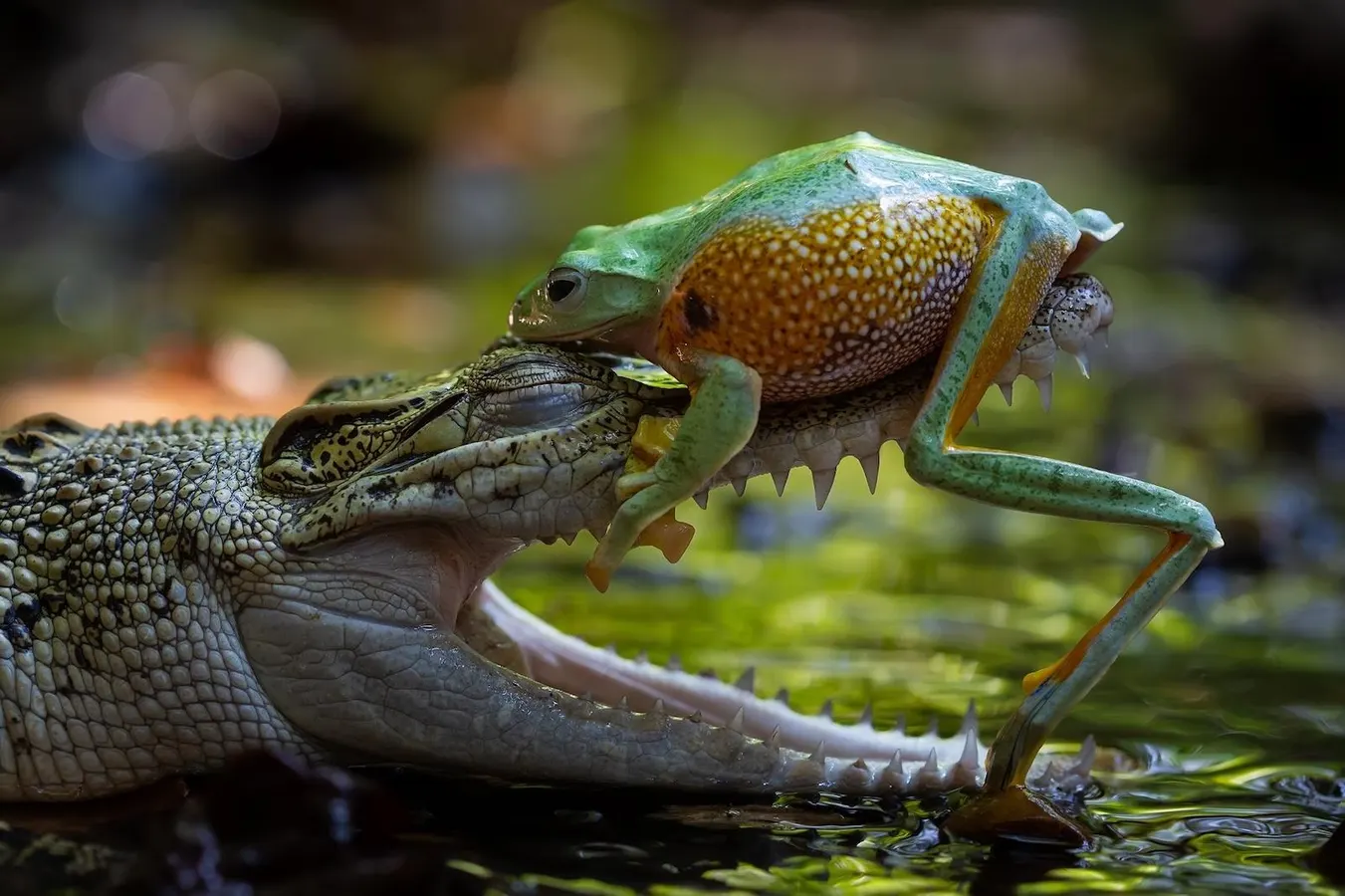Copyright forbes

Take a closer look at how 2025’s best nature photos turn everyday wild moments into stunning stories of life on Earth. By © Genia Ikhfa Anindita, at age 13, of Haruai, Tabalong, Indonesia Every year, the Nature’s Best Photography Award brings together photographers who document the full spectrum of nature, from wildlife to the natural creativity, intellect and adaptability found in every ecosystem. The 2025 Awards carries on this legacy, and stands out particularly for its remarkable blurring of the lines between art and science. These photographs bring forth a nuanced interpretation of the natural environment. Every work of art, from the bioluminescence of insects to the fractal symmetry of icicles, is a biological narrative. When taken as a whole, they serve as a reminder that wind, water, evolution and time can be the planet’s greatest natural painters. These are ten stunning examples of “Art in Nature” from the 2025 Nature’s Best Photography Awards. 1. Grizzly Bear Crossing (Lake Clark National Park & Preserve, Alaska) — Category Winner Grizzly bear crossing By © Henry H. Holdsworth of Jackson, Wyoming, USA This photograph shows a grizzly bear’s (Ursus arctos horribilis) preserved tracks, across the plains of Lake Clark National Park in Alaska. Grizzlies, unlike most large mammals, are plantigrade walkers. This means, according to a study on bear locomotion, that they place their full foot flat on the ground to produce remarkably deep and evenly dispersed prints. Scientists have seen a clear “M-shaped” pressure pattern because their hindlimbs generate greater vertical and lateral force than their forelimbs. MORE FOR YOU Although this gait may appear leisurely, it actually represents a strong, energy-efficient stride adapted for endurance and terrain stability. This gait compacts and aerates the soil by reshaping the terrain it traverses. The photograph, then, is a record of how movement itself turns into a kind of ecological engineering, rather than just a portrait of passage. 2. Owlfly (Vence, France) By © Thibault Andrieux of Mougins, Alpes-Maritimes, France Here, an insect perches against a black background, making its golden shape vanish into the dry bush it is perched on. It may appear to be a dragonfly at first, but its clubbed antennae and wing wrapping indicate that it is actually an owlfly (family Ascalaphidae, order Neuroptera). Owlflies are predatory insects that are found throughout tropical climates and parts of southern Europe. Their resemblance to their surroundings is no coincidence. Owlflies use camouflage even as larvae, hiding under pieces of bark or other debris to attack unwary victims. The same impulse appears as adaptive coloring in adulthood. In this instance, the plant and bug have the same ochre color, reflecting the sun-bleached tones of the dry season in the Mediterranean. 3. Desert Layers (Rub’ Al-Khali, United Arab Emirates) Desert layers By © Matteo Strassera of Rome, Italy The Rub’ al-Khali, better known for being the world’s largest continuous sand desert, stretches across the Arabian Peninsula like a vast field of patterns. The orange ridges and layered textures seen here are a result of precise physical processes that govern dune formation. Research on aeolian dune dynamics shows that sand movement results from three factors, namely the interaction between: Grain motion Surface shape As wind propels grains into short hopping movements, known as saltation, the sand flux stabilizes over a distance called the saturation length. This self-regulating process determines a dune’s height, slope and spacing. This photo, in particular, emphasizes the two main kinds of dunes. We see one in which the heaps are smooth and even, created at the critical point where the energy of the wind diffuses slowly. We also see slip-faced dunes, in which deposited sand pours down the leeward side. 4. Eros Blue Butterflies (Qinghai, China) Eros blue butterflies By © Haiyong Cai of Qinghai, China If you look too quickly, the pale blue forms of the butterflies in this photograph resemble tiny flowers on alpine shrubs. The Eros blue butterfly (Polyommatus eros) is native to Qinghai’s high plateau, and it owes its striking coloration to the microscopic structure of its wing scales. A genomic study on its close cousin, Polyommatus icarus (the common blue), has revealed more than 13,000 protein-coding genes; several of these codes are responsible for building the same nanostructures for the Eros blue. The scales are structured in such a way that it allows light to scatter and refract, creating the metallic blue that defines the species and separates them from the family. This structural feature also aids in heat regulation, helping the butterflies survive in thin, cold mountain air. 5. Bell-Shaped Icicles (Eagle River, Alaska) Bell shaped icicles. By Ray Bulson of Eagle River, Alaska, USA This black-and-white photo highlights the little details observed in nature. In this photo especially, the bell-shaped icicles hanging over the Eagle River are photographed reflected in the flowing water underneath. These formations result from repeated freeze-thaw cycles, as water droplets partially freeze along their edges. Asymmetrical freezing traps thin layers of air, which gives rise to the formation of the curved bottoms. This entraps thin films of air that influences how light passes through the ice and how it ultimately reflects. Under this frozen cover, the river still sustains microbial life and aquatic invertebrates, even in subzero temperatures. The photo underscores the natural process of cryogenesis, which is what constantly refigures many of Earth’s cold-water habitats. 6. Shining Antlers (Hokkaido, Japan) Shining antlers By © Kohei Nagira of Izumo, Shimane, Japan In this photograph, a Yezo sika deer (Cervus nippon yesoensis) stands tall at daybreak, with the fine hairs on its antlers outlined in a glowing, golden hue. Japan’s male Sika Deer, particularly suited for its temperate ecosystems, grow new antlers every spring. This is due to their rising testosterone levels, which trigger bone development beneath the soft, vascular layer we see glowing in this photo — known as velvet. The antlers harden and shed annually, marking a cyclical process driven by sexual selection and fitness to potential mates. 7. Emerald Lake Reflections (Yoho National Park, Canada) Emerald lake reflections By © Nadeem Sufi of Chesterfield, Missouri, USA A strikingly monochromatic landscape of snow and water is shown stretched across Yoho National Park’s Emerald Lake, punctuated by a lone figure in a red coat. The minimalism of the scene belies the ecological complexity beneath the water’s surface. In peak winters, lakes like Emerald experience “inverse stratification.” In this process, colder ice at the surface (0°C) floats above slightly warmer layers of water (around 4°C) below, which creates a stable environment for fish and plankton to survive under the ice. 8. Path Of The Brittle Star (Luskentyre Beach, Scotland) Path of the brittle star By © Alan Smith of Reading, Berkshire, UK This seemingly abstract path in the sand is actually the path of a brittle star (class Ophiuroidea), a near relative of starfish. They too are five-armed invertebrates, but with much lengthier arms that project from a central disc. These are what allow them to move in a coordinated rowing motion. Research from The Journal of Experimental Biology indicates that brittle stars choose a lead arm to direct locomotion, with the two neighboring arms “rowing” together to move the body forward. To change their direction, they merely give a different limb the lead role, reorganizing locomotion by means of a networked nerve system rather than a central brain. This system permits rapid and coordinated movement in an animal that lacks bilateral symmetry or a centralized control center. Lightly coated in sand for camouflage, brittle stars are significant detritivores playing a key ecological role of recycling organic material found on the ocean floor. 9. Mozambique Ghost Goby (Red Sea, Egypt) Mozambique ghost goby By © Simon Biddie of Edinburgh, Scotland, UK Hardly visible except for its eyes, the Mozambique ghost goby (Pleurosicya mossambica) blends in almost entirely with its coral surroundings. This tiny reef fish displays such well-developed cryptic coloration that, unless looked closely, its body appears almost transparent. The camouflage serves a special role — that is, to avoid predators and ambush small planktonic prey. One of the most diverse of fish groups on coral reefs, gobies have many species forming mutualistic relationships with shrimp or corals. The photograph captures an example of its extreme adaptation, where near invisibility serves as an essential survival trait. 10. Clouds Over Ke’e Beach (Kauai, Hawaii) Clouds over Ke’e beach By © Aaron Feinberg of Kapa’a, Hawai’i, USA The distinctive cloud formation captured in this image forms over Ke’e Beach at dusk, where warm, moist air from the ocean rises and cools, forming a temperature inversion. The island’s trade winds and volcanic terrain shape these kinds of low-lying “sea of clouds” effects. Beyond their visual impact, such weather patterns play an important ecological role: they provide rainfall and mist that sustain Hawaii’s upland forests and native plant species. The photograph highlights how atmospheric processes directly support the island’s biodiversity. These photos remind us just how beautiful nature can be. Take this science-backed test to find out how connected you are to it: Connectedness to Nature Scale Editorial StandardsReprints & Permissions



